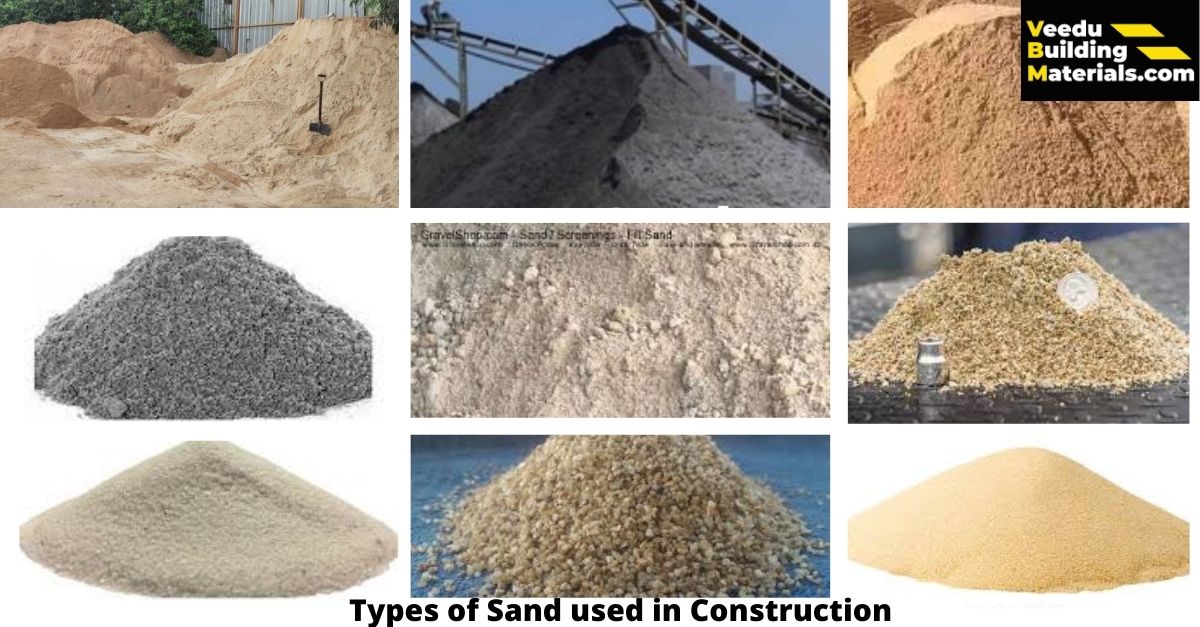Sand is a very basic and pivotal construction material. It provides desired strength and durability to the structures when mixed in the right proportions with coarse aggregates and cement. There are different types of sand available to us. But not every sand is suitable for every construction activity. The right type of sand selection depends upon its characteristics and end-use. One important consideration while selecting the sand is to check for the presence of rocks and other impurities. Because they can adversely impact the stability and resistance of the sand, you’ll learn about different types of sand used in construction in this article. Additionally, where does the building sand come from, i.e., its sources? Also, how are they better suited for certain construction activities.
Nine different types of sand are used in construction
River sand or natural Sand
It is fine-grade sand found on the riverbeds and streams. It has been widely used for many constructional purposes for ages. As a matter of fact, river sand is considered suitable for almost all construction activities, including plastering, brick-works, RCC, etc. Since it comes from riverbeds, it has low water requirements: the smooth texture and trapped moisture results in easy workability. Further, a low level of silt content (5-20%) also makes it economical. Having said all this, the natural river sand is fast depleting due to over-excavation. Its high use in construction activities poses a great threat to the environment.
Pit Sand
Pit sand is obtained from deep underground pits, usually 2-3 meters beneath the surface. The absence of salts and non-reactiveness with moisture provides it with excellent binding properties. Moreover, the sharp, angular, rough, coarse grains also add to its binding strength. The high amount of ‘iron-oxide’ gives it a red-orange color. The most common use of pit sand is for making mortar.
Concrete Sand
As the name suggests, this sand is made of crushed concrete. It is a common ingredient in asphalt and cement mixtures. Concrete blocks are crushed in a quarry, and then large rock fragments are discarded to obtain finer grains. It’s suitable because of the size and texture of its grains for various building purposes. For example, it is suitable for the construction of softer pavements because of its smaller grains compared to crushed stone grains. At the same time, it is also used as a filling material because its grains are larger than that of white sand. It also provides a solid mass for filling the voids between coarse aggregates when mixed with water and cement. It is ideal for constructing walking paths and patios and leveling base layers.
Fill Sand
Fill sand comprises various sand grains and aggregates and is most commonly used for filling. It creates a good base for filling large holes, pavings, and laying concrete. This sand is known for its excellent compassion rating. On the other hand, it is also susceptible to displacement and shifting. Fill sand is quite suitable for use in wet areas with drainage problems. It creates good backfill around septic tanks and the base for the concrete. The affordability factor makes it an attractive option for builders and developers.
Utility sand
Crushed high-quality industrial-grade quartz forms utility sand. The uniformity in grain sizes provides impressive compassion and great mechanical properties to this sand. Its non-reactiveness with water makes it ideal for use in corrosive environments. The 100%presence of natural minerals adds to its durability, stability, and long life.
Industrial sand
High-purity silica sand, used in construction projects, is called industrial sand. This sand provides good flexural strength and packing density. Whole grain silica finds common usage in roofing shingles, flooring compounds, specialty cement, asphalt mixtures, and skid-resistant surfaces. Due to its anti-corrosion and weathering properties, industrial sand acts as a functional extender in caulks, sealants, and epoxy-based compounds.
Coarse sand
Coarse sand is very common in the Indian construction industry. It easily mixes with water, aggregates, and cement to produce high-strength concrete. This sand has varied applications such as – base for concrete slabs/pavers, bedding for pipes and septic systems, top dressing for gardens/ lawns, etc.
Fine Sand
This sand is ideal for giving a smooth finish and even look to the outer walls. That’s why it is best used in plastering works. However, it is often missed with coarse sand to create sturdy and long-lasting structures. Needless to mention, the excellent wall color holding capacity of this sand.
Manufactured sand or Robo Sand
M-sand is gaining huge popularity as a substitute for natural sand. This artificially manufactured sand is now being increasingly used in the construction industry. It is manufactured by crushing hard stones, mainly granite or rocks, to fine particles in a factory or quarry. It is mixed with cement/bitumen and water to form a concrete or mortar mix. Different grades of M sand are manufactured based on their granule thickness. They have varied applications and uses in the construction industry. M-sand helps to protect the environment. Moreover, it fares better in its physical and chemical properties because of the controlled manufacturing process. Further, it is free from most impurities and comes in desired grain sizes as per the usage.
The dry-density of M-sand is 1.75 kg per cubic m.
Common uses of M-sand include:
- Concreting: The sand with granule thickness or the sieve size of 150 microns – 4.75 mm is most suitable for concrete.
- Tilling and plastering: The sand with granule thickness or sieve size is 150 microns – 2.36 mm is the most suitable for tiling and plastering.
- Masonry and brick or blockwork: The sand with the granule thickness or sieve size is 150 microns – 3.55 mm is most suitable for masonry and brick/block laying.
Conclusion
The construction of any building should be a well-thought and well-informed decision. Therefore, careful selection of the right materials becomes pertinent. When choosing sand, one should be mindful of the silt and other organic impurities. Equally important is to take note of the characteristics of sand that make them suitable/unsuitable for different construction purposes. This article discusses the various types of sand used in construction. Please check our resources page for other materials used in construction.


Leave a Reply